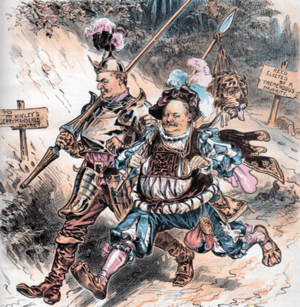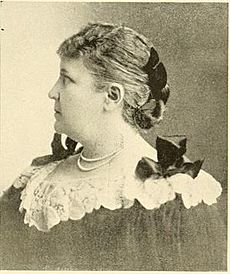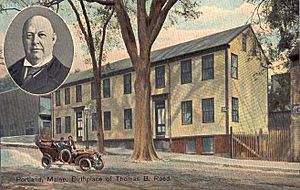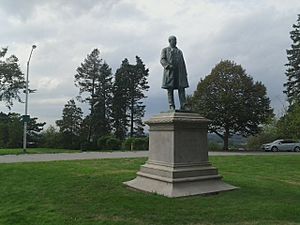Thomas Brackett Reed facts for kids
Quick facts for kids
Thomas Brackett Reed
|
|
|---|---|

Reed c. 1870s
|
|
| 32nd Speaker of the United States House of Representatives | |
| In office December 2, 1895 – September 4, 1899 |
|
| Preceded by | Charles F. Crisp |
| Succeeded by | David B. Henderson |
| In office December 4, 1889 – March 3, 1891 |
|
| Preceded by | John G. Carlisle |
| Succeeded by | Charles F. Crisp |
| Leader of the House Republican Conference |
|
| In office December 4, 1889 – March 3, 1899 |
|
| Preceded by | James G. Blaine |
| Succeeded by | David B. Henderson |
| Member of the U.S. House of Representatives from Maine's 1st district |
|
| In office March 4, 1877 – September 4, 1899 |
|
| Preceded by | John H. Burleigh |
| Succeeded by | Amos L. Allen |
| Maine Attorney General | |
| In office 1870–1872 |
|
| Governor | Joshua Chamberlain Sidney Perham |
| Preceded by | William P. Frye |
| Succeeded by | Harris M. Plaisted |
| Member of the Maine Senate | |
| In office 1870 |
|
| Member of the Maine House of Representatives | |
| In office 1868–1869 |
|
| Personal details | |
| Born | October 18, 1839 Portland, Maine, U.S. |
| Died | December 7, 1902 (aged 63) Washington, D.C., U.S. |
| Resting place | Evergreen Cemetery, Portland, Maine |
| Political party | Republican |
| Spouse |
Susan P. Merrill
(m. 1871) |
| Children | Katherine Reed Balentine |
| Alma mater | Bowdoin College |
| Profession | Attorney |
| Signature | |
Thomas Brackett Reed (born October 18, 1839, died December 7, 1902) was an important American politician from Maine. He was a member of the Republican Party. Reed was elected to the United States House of Representatives 12 times, starting in 1876.
He served as the Speaker of the House twice. His terms were from 1889 to 1891 and again from 1895 to 1899. People sometimes called him "Czar Reed" because he had a lot of power. He changed how the House worked more than any Speaker before him.
Reed created the "Reed Rules" to make the Speaker's job stronger. These rules made it harder for the minority party to stop new laws from being passed. He also helped pass the Lodge Bill. This bill aimed to protect the voting rights of African Americans. However, it did not become law because it failed in the Senate. Reed did not support the Spanish–American War. He left Congress in 1899 because of this disagreement.
Contents
Early Life and Career
Thomas Reed was born in Portland, Maine, on October 18, 1839. His parents were Matilda Prince (Mitchell) and Thomas B. Reed. He went to public schools, including Portland High School. Later, he graduated from Bowdoin College in 1860.
After college, Reed studied law. He became a lawyer in 1865. During the Civil War, he worked for the United States Navy. He was an assistant paymaster from April 1864 to November 1865. After the war, he practiced law in Portland.
Reed began his political career in Maine. He was elected to the Maine House of Representatives in 1868 and 1869. In 1870, he served in the Maine Senate. He then became the state's Attorney General from 1870 to 1872. From 1874 to 1877, he was the city lawyer for Portland. In 1876, he was elected to the 45th Congress as a Republican.
Time in the House of Representatives
Reed was known for his sharp and clever humor. Once, when asked if his party might choose him for President, he said, "They could do worse, and they probably will." He was also very tall, over 6 feet, and weighed more than 300 pounds. This made him stand out.
He was friends with many important thinkers and politicians. These included Henry Cabot Lodge, Theodore Roosevelt, and Mark Twain. As a new member of the House, Reed joined the Potter Commission. This group looked into problems with the 1876 presidential election. His skill at asking questions made a Democrat named Samuel J. Tilden appear in person.
Reed led important committees in the House. He chaired the Committee on the Judiciary. He also led the powerful Rules Committee for several terms.
Speaker of the House
Reed became Speaker after a tough contest with William McKinley. He won with the help of young Theodore Roosevelt. Roosevelt's influence as a new Civil Service Commissioner was very important. Reed served as Speaker from 1889 to 1891 and again from 1895 to 1899. He also led the powerful Rules Committee.
Reed Rules and House Power
As Speaker, Reed greatly increased the Speaker's power. Before him, the Speaker had influence but not as much direct control. Reed believed that "The best system is to have one party govern and the other party watch." He wanted to make sure the majority party could get things done.
He studied the House's old rules, many written by Thomas Jefferson. Reed wanted to stop the minority party from blocking work. They would often do this by refusing to answer a quorum call. A quorum is the minimum number of members needed to do business. If members were present but did not answer, they were not counted. This stopped the House from moving forward. This tactic was called the "disappearing quorum."
Reed's solution became law on January 29, 1890. This event is known as the "Battle of the Reed Rules."
The conflict started when Democrats tried to stop a new Republican from West Virginia from joining. The vote to seat him passed 162 to 1. But a quorum needed 165 votes. When the vote closed, Democrats shouted, "No quorum!" This led to a formal count. Reed started calling names. When members present refused to answer, Reed told the Clerk to count them as present.
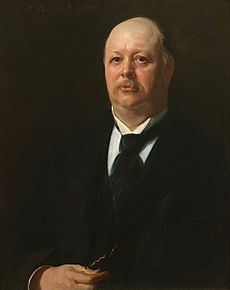
Democrats were very upset. They yelled and insulted Reed. A Democrat from Kentucky named James B. McCreary questioned Reed's power. Reed replied, "The Chair is making a statement of fact that the gentleman from Kentucky is present. Does he deny it?"
Since they were clearly there, Democrats tried to run out or hide. But Reed ordered the doors locked. Only one Representative, Constantine B. Kilgore, managed to escape by kicking a door open.
The fight over the rules lasted three days. Democrats tried to delay things by challenging Reed's actions. Finally, on January 31, they gave up. The new Republican member was seated on February 3.
Six days later, Reed's new "Reed Rules" were approved. These rules ended the disappearing quorum. They also lowered the number of members needed for a quorum to 100. When Democrats took control of the House later, they brought back the disappearing quorum. But Reed, as the minority leader, used this tactic so well against them. Because of this, Democrats brought back the Reed Rules in 1894.
Civil Rights and Later Career
In 1889 and 1890, Republicans tried to protect voting rights for Black Americans. This was based on the Fifteenth Amendment. Reed was very interested in this effort. Using his new rules, he helped pass the Lodge Bill in the House in 1890. However, the bill was stopped in the Senate.
Reed wanted to become President in 1896. But Mark Hanna helped Ohio Governor William McKinley get the nomination instead.
In 1898, Reed worked with McKinley to avoid war with Spain. But when McKinley decided to support the Spanish–American War, Reed disagreed. He refused to change his mind. In 1899, he resigned from being Speaker and from Congress. He then returned to working as a lawyer.
Personal Life
Thomas Reed married Susan P. Merrill in 1871. Susan was born in Center Harbor, New Hampshire. Her father, Rev. Samuel H. Merrill, was a well-known Congregational minister. He was a pastor in Center Harbor when Susan was born. Six years later, her family moved back to Maine. During the Civil War, her father was a chaplain. Susan also had a brother who served in the First Maine Cavalry.
Susan Merrill and Thomas Reed were childhood friends. They went to school together in Portland. After they married, Reed was a member of the Maine Legislature. They had one daughter named Katherine.
Their daughter, Katherine Reed Balentine, later started a magazine. It was called The Yellow Ribbon and promoted women's suffrage. This means it supported women's right to vote.
Death and Legacy
In early December 1902, Reed was in Washington, D.C. He was working on legal cases with the United States Supreme Court. On December 2, he visited his old colleagues in the Ways and Means Committee room. Later that day, he became sick at the Capitol. He was quickly taken to the nearby Arlington Hotel.
Doctors said Reed had Bright's disease, a kidney problem, along with appendicitis. He died five days later, on December 7, 1902. His wife and daughter were with him. A dinner was happening at the same hotel. When people heard of Reed's death, they stood up to honor him.
Henry Cabot Lodge said Reed "detested shams, humbugs and pretense above all else." Mark Twain wrote that Reed was "transparently honest and honorable." He also said Reed was "wise, shrewd and alert." Reed was buried in Evergreen Cemetery in Portland, Maine.
There is a building named Reed House at Bowdoin College. His hometown of Portland, Maine, put up a statue of him in 1910. His last home in Portland is now a National Historic Landmark.
In 1894, Reed published a book called Reed's Rules: A Manual of General Parliamentary Law. This book was very popular. It is still used in the legislature of Washington State today.
Many books have been written about Thomas Brackett Reed's life. These include biographies by Samuel McCall, William A. Robinson, and Richard Stanley Offenberg. Finance writer James Grant also wrote a book about him. The most recent book is by Robert J. Klotz. One chapter of Barbara Tuchman's book The Proud Tower is also about Reed.


